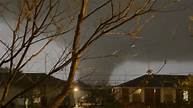In recognition of Ohio’s Spring Severe Weather Awareness Week (March 20-26), the university’s Office of Resiliency is providing important information and suggestions on how to prepare for inclement weather in Ohio.
During the spring, there is an increased possibility of flooding, severe thunderstorms and tornadoes, along with high winds, hail and lightning. And though tornadoes can occur at any time, they are more common in late spring and early summer.
According to the National Weather Service (NWS), 20 tornadoes occurred in Ohio in 2020. To help better prepare for these events, here are a few safety tips:
D – Go DOWN to the lowest level
U – Get UNDER something
C – COVER your head
K – KEEP sheltering until the storm passes
Before a Tornado
Know the signs of a tornado:
- Dark, green sky
- Hail
- Dark, low clouds
- Loud roar
Know the difference between a tornado watch and a warning:
- Tornado Watch – A tornado is possible
- Tornado Warning – A tornado is happening or imminent
During a Tornado
- Find shelter in the lowest level of a sturdy building immediately.
- If outside, get into your vehicle, buckle your seatbelt, and drive to a sturdy building.
- If debris is flying while driving, pull over and park. You can stay in your vehicle with your seatbelt buckled and the windows closed or exit the vehicle and kneel facedown in a ditch with your hands protecting your head.
- Do NOT seek shelter under bridges.
After a Tornado
- Tap on a pipe or wall if you are trapped, so rescuers can find you.
- Listen to officials for updates.
- Check in with your family and friends.
- Watch for downed power lines and debris.
- Do not go into damaged buildings until authorities indicate that it is safe.
- Photograph any damage to your property.
Learn more about tornado facts and safety tips.
As always, it’s important to make sure your contact information is up to date in Case Western Reserve University’s Rave emergency communications system so we can contact you in the event of an emergency—whether severe weather or otherwise. Check your contact information today.

